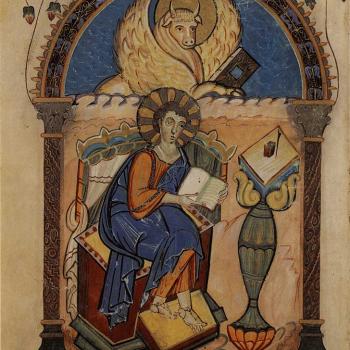
(Wikimedia Commons).
This past summer, I was reading Jessica Coope’s monograph on the Martyrs of Córdoba. While discussing the religious climate in the ninth-century capital of al-Andalus, she says the following:
“…[B]y the ninth century a hadith was generally accepted which states that all babies are squeezed at birth by Satan (that is why they cry), but that Mary and Jesus escaped this contact with the devil; behind this tradition seems to lie an echo of the immaculate conception.”[1]
In Islam, a hadith is a saying that is believed to have been uttered by Muhammad, and passed down through a reliable chain of transmission called an isnad. The hadith that Coope refers to appears to be that found in Sahih Muslim (Book 30, Number 5837). It reads in full:
“Abu Huraira reported Allaah’s Messenger (sallAllaahu alayhi wa sallam) as saying: No child is born but he is pricked by the satan and he begins to weep because of the pricking of the satan except the son of Mary and his mother. Abu Huraira then said: You may recite if you so like (the verse):’ I seek Thy protection for her and her offspring against satan the accursed’ (iii. 36). This hadith has been narrated on the authority of Zuhri with the same chain of transmitters (and the words are):’ The newborn child is touched by the satan (when he comes in the world) and he starts crying because of the touch of satan.’ In the hadith transmitted on the authority of Shu’aib there is a slight variation of wording.”[2]
It is an interesting observation. In this hadith Christ and the Virgin Mary are clearly said to be exempt from what every human must endure. What is this prick by Satan? It cannot be the stain of original sin, for Islam has no such concept.[3] But a belief in original sin underlies the dogma of the Immaculate Conception of Mary, which is contained within the bull of Pope Pius IX, Ineffablis Deus:
“Wherefore, in humility and fasting, we unceasingly offered our private prayers as well as the public prayers of the Church to God the Father through his Son, that he would deign to direct and strengthen our mind by the power of the Holy Spirit. In like manner did we implore the help of the entire heavenly host as we ardently invoked the Paraclete. Accordingly, by the inspiration of the Holy Spirit, for the honor of the Holy and undivided Trinity, for the glory and adornment of the Virgin Mother of God, for the exaltation of the Catholic Faith, and for the furtherance of the Catholic religion, by the authority of Jesus Christ our Lord, of the Blessed Apostles Peter and Paul, and by our own: ‘We declare, pronounce, and define that the doctrine which holds that the most Blessed Virgin Mary, in the first instance of her conception, by a singular grace and privilege granted by Almighty God, in view of the merits of Jesus Christ, the Savior of the human race, was preserved free from all stain of original sin, is a doctrine revealed by God and therefore to be believed firmly and constantly by all the faithful.’[29]”[4]
What then does the hadith mean? I am unsure, but it is certainly not identical to the Immaculate Conception. Is Coope correct that “behind this tradition seems to lie an echo of the immaculate conception”? I am uncertain as well, but it is an interesting observation nonetheless; one that calls for some sort of explanation.
Thanks for reading! Please consider leaving a comment or subscribing.
[1] Jessica Coope. The Martyrs of Córdoba: Community and Family Conflict in an Age of Mass Conversion. (Lincoln: University of Nebraska Press, 1995), 45. Emphasis mine.
[2] http://www.sahihmuslim.com/sps/smm/sahihmuslim.cfm?scn=dspchaptersfull&BookID=30&ChapterID=994 , (accessed 12-8-2019). Emphasis mine.
[3] John L. Esposito. The Oxford Dictionary of Islam. (New York: Oxford University Press, 2003), 295.
[4] https://www.papalencyclicals.net/pius09/p9ineff.htm , (accessed 12-8-2019). Emphasis mine.












